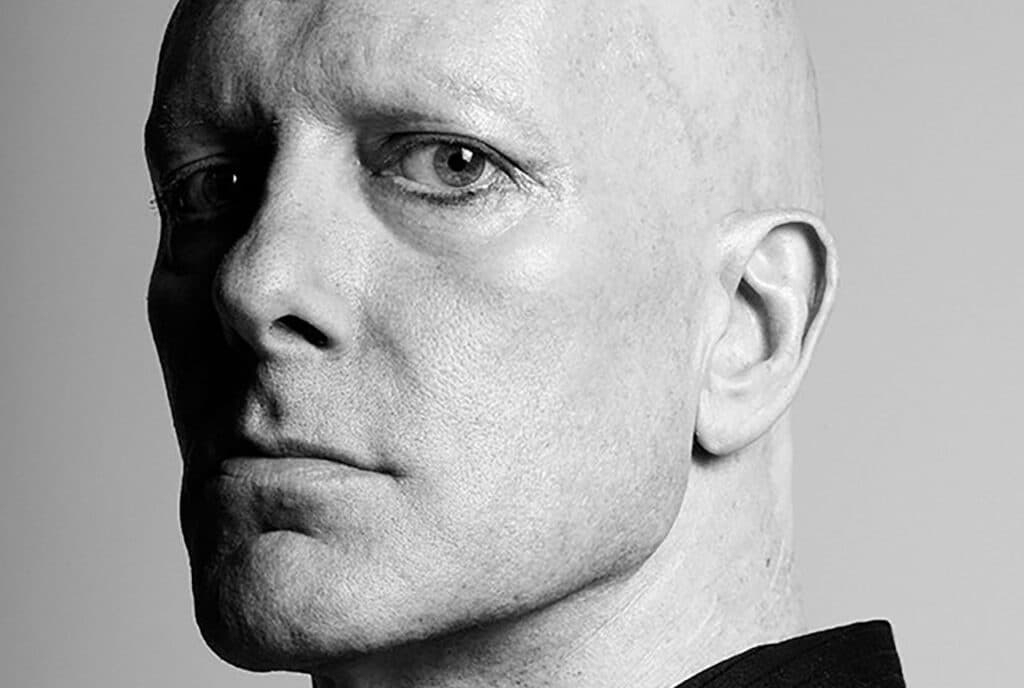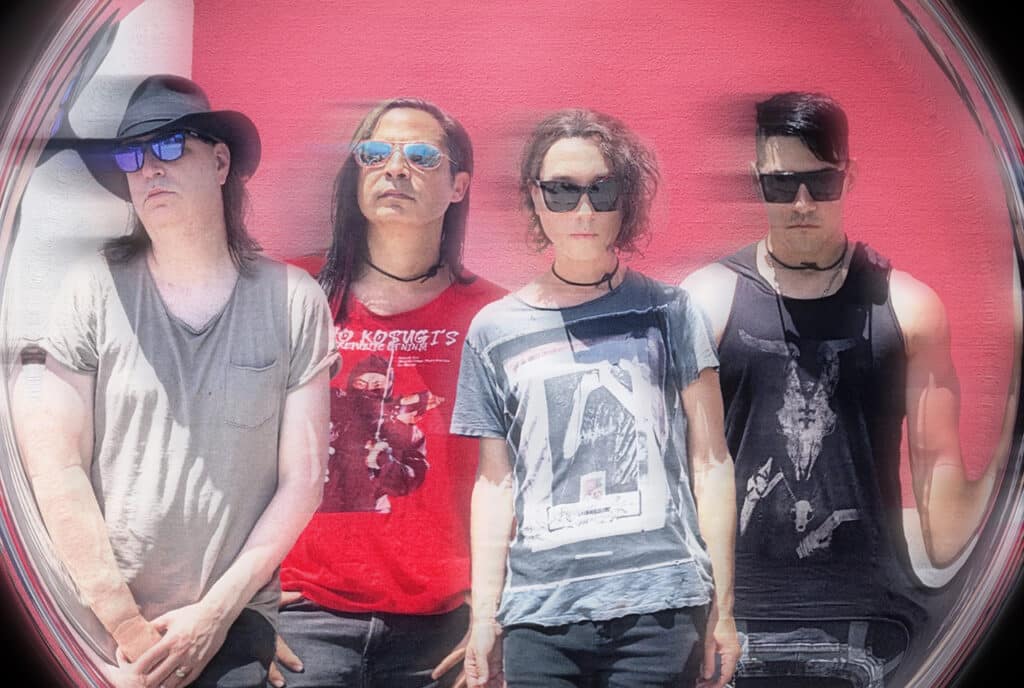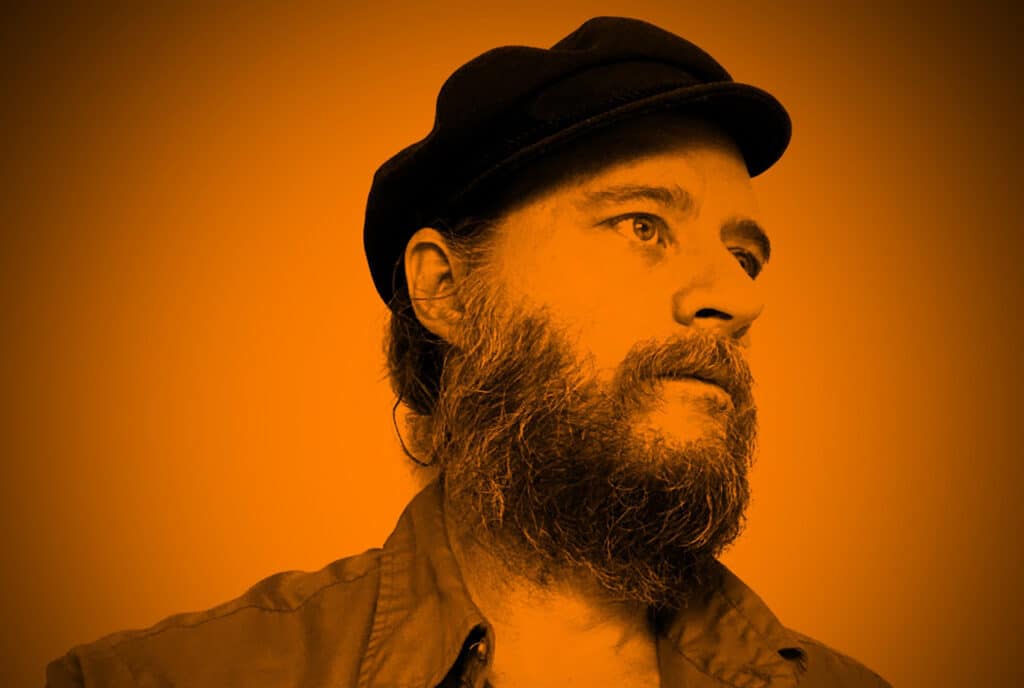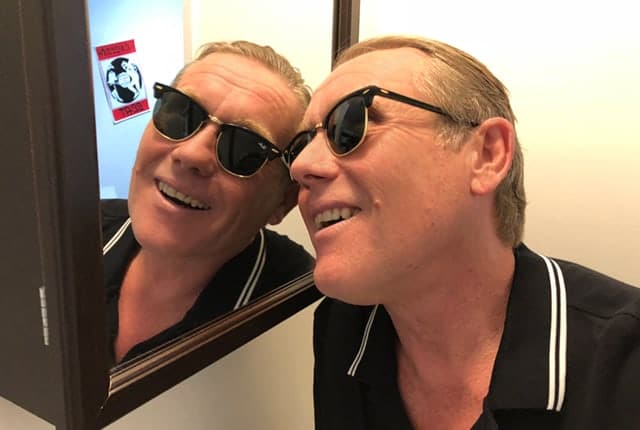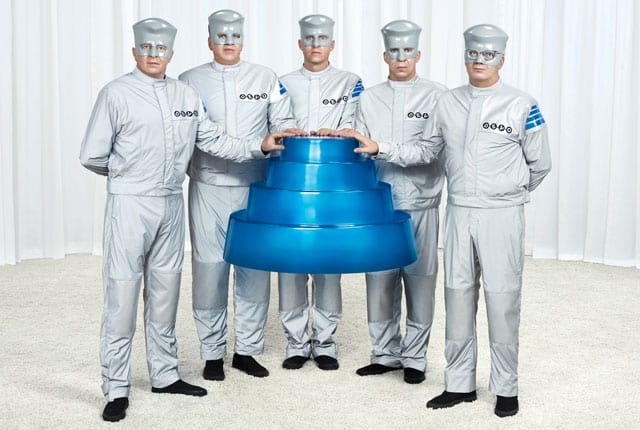On their third album, The Drowned Ground, Mojave duo Less Bells continue to span multiple genres as they blend electronic and acoustic sounds into a unique style. The viola takes on a prominent role this time around, joining the usual violin and cello arrangements from Julie Carpenter. Strings fit perfectly with the synthesizer work of Dain Luscombe, on instruments including the Buchla, Moog modular, and Prophet 5. Less Bells also bring in other instruments such as the hurdy-gurdy and shahi baaja and make use of environmental samples. The desert itself plays a part in their work, with the sonic palette including recordings of sounds like coyote howls and gusts of wind.
Prior to starting Less Bells, Carpenter had done session violin work and toured with artists such as Love with Arthur Lee, Eels, and Spiritualized. Luscombe had been composing for TV and film, and toured as a keyboardist with Marjorie Fair and Bell Gardens. They began Less Bells when they left Los Angeles for the California desert of Joshua Tree.
Over a Zoom interview, Carpenter and Luscombe discussed The Drowned Ground and the creative process behind it.
This is your third release; did you have any specific goals or ideas going into making it compared to your previous albums?
Julie Carpenter: I don’t know if it’s different from the previous albums. A lot of times I’m kind of inspired for themes; it feels like a theme will emerge. I was reading a lot of books about archaeology and deep time and layers. So it’s a lot of layers and a lot of thoughts about sort of anachronism and things being layered and combined that you wouldn’t necessarily expect.
Dain Luscombe: Yeah. Then like the pandemic too.
Julie Carpenter: This was all being written in 2020 and 2021, like the bulk of the creativity. So it was a really strange time to be making things, as I’m sure you remember.
It sort of felt both pointless and necessary at the same time, and everything felt very dangerous. We live out in Joshua Tree in the desert. So we were very isolated already. We were kind of trying to digest this strange new world that we seem to be in. I think there are elements of that running through it, whether we want there to be or not.
Did that affect the amount of time that you spent on it? Did you perhaps have fewer other things going on due to the pandemic?
Julie Carpenter: I think it did, but unfortunately I feel like I spent a lot of time on it, and a lot of that time was stuff that you don’t hear on the record. There’s a lot of experimenting and throwing things away, which is good to do. Because I think we don’t normally feel like we have the time to do that, the time to risk experiments that you know you’re not going yo keep. Or maybe you don’t know at the time, but you go on and say, “no, I didn’t like any of that.” So I think there was some wandering down hallways, putting something together and then going, “no, that’s not it.” Maybe more than we normally would’ve.
When you do that, do things really get thrown away and new thought of again? Do you ever look back on things you may have cast aside and maybe have it spark something else?
Dain Luscombe: She throws it away.
Julie Carpenter: I have gone back and used it. Something I deleted from the album ended up getting used in a film we just scored. Things sometimes find their place, but maybe the album isn’t the right place. So yeah, that does happen. Sometimes I just don’t want anyone to see it and it just goes away.
Dain Luscombe: There was probably like twice as much material as is on the album. That we recorded and worked pretty hard on. Like, no one will ever hear that stuff.
Julie Carpenter: I mean, who knows? It may get recycled and cut up and put into the next thing.
I think a lot of it is the sculpture thing, where you start realizing which pieces don’t belong, and you start realizing these things all have this thing in common, let’s put them here. These other things maybe, maybe don’t feel right. They just don’t. They’re clashing with the feeling or the mood. It’s all starting to convey a thing and you start choosing the art and the titles and all these things kind of come together to make your piece, that you’re trying to present as an album and get your ideas across. Some of those things are gonna be part of a different idea.
At what point in the process do you think you really had a firm grasp as to what you were going for?
Dain Luscombe: Never.
Julie Carpenter: Maybe now, maybe when I got the records in the box. No, I think for some reason getting an album title, distilling the title really helps me because then I sort of feel like I have this distillation of what the album is about. So I think “The Drowned Ground” was an idea that I had, it was from a nightmare. It was something that was said to me in the nightmare, and it was sort of my way of taking that thing that I woke up with a lot of panic about, and taking it back and creating something beautiful out of it instead of having it be a moment of anxiety.
Your music has an interesting combination of different types of sounds. What is your creative process like? Do you generally start out with a particular instrument or type of sound, and build upon that? Does it vary by track or do you have like a general working process, in terms of like sculpting these songs?
Julie Carpenter: We pitch things back and forth to each other a lot.
A lot of the pieces will start with the string work first with kind of a little core melody idea, but sometimes it will also start with a germ of something he’s done on an electronic instrument, on the Buchla or something like that. It’ll be, “ah, there’s this, there’s this little world. How can we inhabit it?” So then we tend to not talk about what we’re trying to do all while we’re doing it. We just, we almost play this sort of this letter writing game almost, where I’ll do a pass through, he’ll make a pass through, give it back to me. I’ll go take a bunch of things out, add more things, and then we go back and forth until we feel like we found it. We sort of don’t talk about what we’re trying to do until it’s done. It’s very strange.
Dain Luscombe: If we talked about it, we would end up fighting. So we don’t talk about it. We just go through. Erase things. The person probably worked for hours on, throw them away and …
Julie Carpenter: We do save a version, “Save As” is very important. So we’ll just work through things and kind of …
Dain Luscombe: I’ve never gone back to a “Save As”. Have you?
Julie Carpenter: Oh gosh. Probably not. I think it’s just a courtesy.
Dain Luscombe: We always have a backup. Like, I threw away half of your song, I’m sorry, you know, you can go back. I don’t think either of us have ever gone back.
Julie Carpenter: Yeah. I don’t think so. There’s a lot of trust involved in that process. You have to really believe that the other person’s ideas are going to be as good or better than yours. I think often they are. I played in bands that had lots of people in them for many years and that was one process where I really learned the value of what other people bring to something. Sometimes in ambient music, people work alone or almost alone. You can really benefit from not being so stuck in your own head and so dedicated to your exact vision of how the piece was gonna go. Because he’ll think of putting things on, that I would never have chosen to be there. When I hear them, I’m like, of course, that absolutely belonged there.
So given that process, is it always obvious when a song is done?
Dain Luscombe: I find it really fascinating. We work a lot in commercial music and TV music and stuff like that. And we’ve been doing it for so long that there is a situation where you listen to a song and it seems obvious. It seems like there are no choices. You just have to go do this and do this. And so, I wanna say no, but yes. I mean, I don’t know. It’s interesting.
Julie Carpenter: Yeah. I think there is usually a point where I feel like anything I’m adding to this from this point on will not make it better. It could make it more, it could make it more elaborate, but it isn’t going to make it any more true. So I think that’s the stopping point that you’re looking for, and you do this a lot in film music and commercial music. Everything you’re adding is taking up sonic space. And so when that space is full, anything you add, you need to take something else out. Because you’re just confusing the listener. You’re not getting across what you’re trying to convey.
Since you’ve both been involved with other projects, I’m wondering if there are particular things that you feel you bring from your other work into Less Bells? And are there things that you see this as an outlet for that you might not get to do elsewhere?
Dain Luscombe: Oh, we’ve definitely taken skills that we’ve learned in other projects. We’ve also definitely taken music and gone, ‘oh, this isn’t right for this project. We need to move this over here.’ One of my favorite stories, that I actually didn’t do on this album as much, but on the first two albums with Julie, she would bring me these songs and they were massive sprawling songs. And I would listen to them and go, ‘this is at least two songs, if not three.’ And so I would sit down and literally do surgery on these songs and chop them up and take one part, and that will be the song. And then take another part. And that will [be another]. It was almost like she was writing an entire album in one song, which is fantastic for a lot of people, and I’m sure some people would eat that up.
But it was too much. And I’m like, ‘you know, you can strip this down and it’ll actually be better and more succinct and stuff like that.’ But yeah, working in other musical avenues has totally taught us how to finish things, how to take away, how to edit. It’s been a huge plus in that regard because when we were starting out, we would just stack and stack and stack, and more was always better. I still kind of worry that the Less Bells stuff is too minimal. I don’t know. I don’t know how other people see it. For us, it’s kind of a known quantity, but I’m always kind of wondering. Like my parents, do my parents even consider this to be music? I don’t know.
Julie Carpenter: Probably not. But that’s okay. It doesn’t have to be a flavor for everybody. I think that what I’ve really enjoyed learning from TV and film music is narrative structure. I always kind of have a cinematic scene in my head when I’m making these things, whether or not I actually have one or not. So there’s a very visual aspect to music for me, where I’m kind of almost assigning these little roles to instruments or to melodies. Like, this is our hero melody. This is our hero instrument. This is our conflict. There’s this narrative structure that’s kind of underlying all the ambient stuff. Which is, I think, a little bit unusual in the genre because a lot of acts don’t have that at all. That’s not their thing. And that serves a purpose too. I love a lot of that music. But I think for me, the thing that emotionally brings you into that world is having this underlying narrative, whether or not the listener ever knows about it.
To what degree might you be inspired by your environment, being in the desert? Does that impact your approach to music songwriting?
Julie Carpenter: Oh, absolutely. I mean, there’s literally desert sounds on the album that we’ve gone out and captured with field recording stuff. And the wind here is its own living instrument. We live in a giant wind instrument, basically. Because we’re at the foot of a mountain, so we get these big rushing winds at 25, 30 miles an hour. They’re just bending the trees. So the house shakes and you couldn’t help but be affected by the drama. It’s very dramatic and very noisy, and it’s a weird way. And the coyote howls. There’s coyote howls on the record. There’s all this stuff that’s just part of our sound palette.
Dain Luscombe: We were in bands in LA before we came out here, and listening to the music now, it’s night and day. It’s a completely different sound palette.
Dain Luscombe: Like, I don’t even know. I, I don’t even know how to quantify it, but everything is much more organic and dirty. I couldn’t see doing synth pop out here.
Julie Carpenter: Yeah. There, there’s an intrinsic folkiness, I think, that has come into it more and more. And on this record, I’ve started researching alternate tunings a lot and getting into, strangely enough, more like Celtic fiddle music and things like that. that have different tunings, because I really like that open … something about the resonance of the open strings where you will tune everything to a chord somehow that has this organic thing to it that blends with this environment, even though it’s from a totally different environment as well. There’s something very organic and gritty. It’s gritty and alive.
The Drowned Ground can be purchased at lessbells.bandcamp.com.


